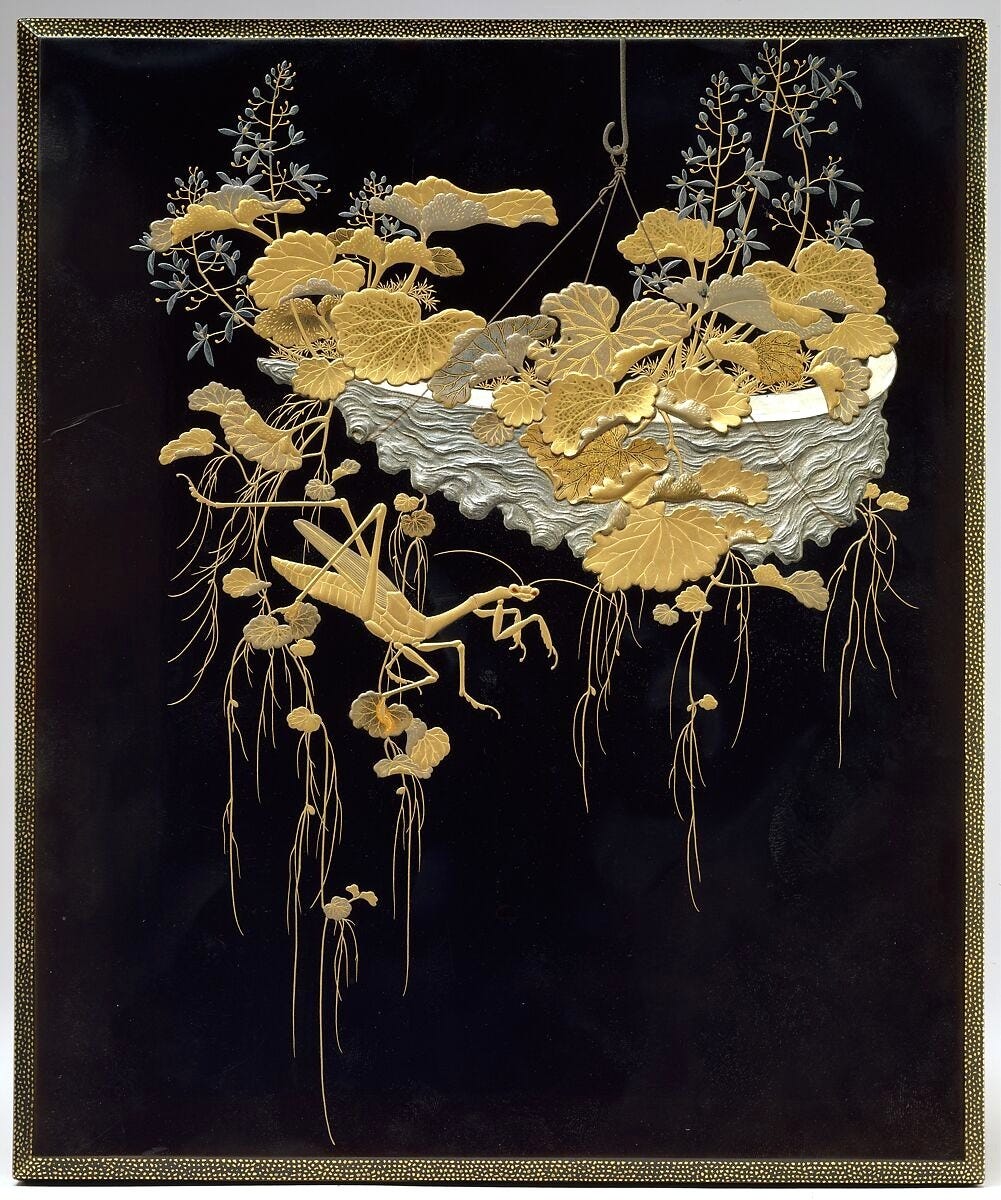
There is profound beauty to the art of writing…leading to the the power of the written word. As a decorative arts historian, I also find beauty and comfort in viewing objects that ‘contained’ these precious writing tools. Many would view these objects as simply artifacts from the past with no relevance to the way we write today- pounding out letters on a computer keyboard. I beg to differ. There is something to be said for composing our thoughts on paper. And there are creative people who still do this- novelists, Neil Gamen, Amy Tan, & Joshua Ferris; poet, Joyce Carol Oates; and filmmakers- Quentin Tarantino & Akira Kurosawa.
It was reading Kurosawa’s process of writing that impacted me the most in writing this newsletter. “I write down my reactions and what particularly moves me. I have stacks and stacks of these college notebooks, and when I go off to write a script, these are what I read. Somewhere they always provide me with a point of breakthrough. Even for single lines of dialogue I have taken hints from these notebooks.”…"The essential tools for crafting a screenplay are as simple as paper and a pencil.”
These words made me reflect on my own writing process. Do I use a computer to write? Of course. Do I jot down on paper my thoughts, ideas, feelings I want to refer back to when I begin writing? I do. I cannot imagine not having these notes, in my own handwritten scribble, to view as I’m composing. There’s something so personal and organic in putting pen to paper.
Referencing Kurosawa’s quote above- when he speaks of essential tools for screenwriting- he says that these are as simple as paper and pencil. But, he also said, “In order to write scripts, you must first study the great novels and dramas of the world. You must consider why they are great.” This reveals that one should be students of the past as there are intricate nuances of a society’s culture which we can choose to embrace or dispel in our modern world.
The writing boxes presented here provide intricate nuances as they are decorated with images, motifs and patterns that are potent symbols of a particular culture.
There’s another layer to their beauty- they represent a scholarly life of writing and reading.
Note: For the purposes of this curated newsletter, only East Asia and India & the Islamic World will be featured as there are common themes throughout these regions.
Nature flourishes in East Asian Writing boxes…
East Asia- China, Japan, & Korea
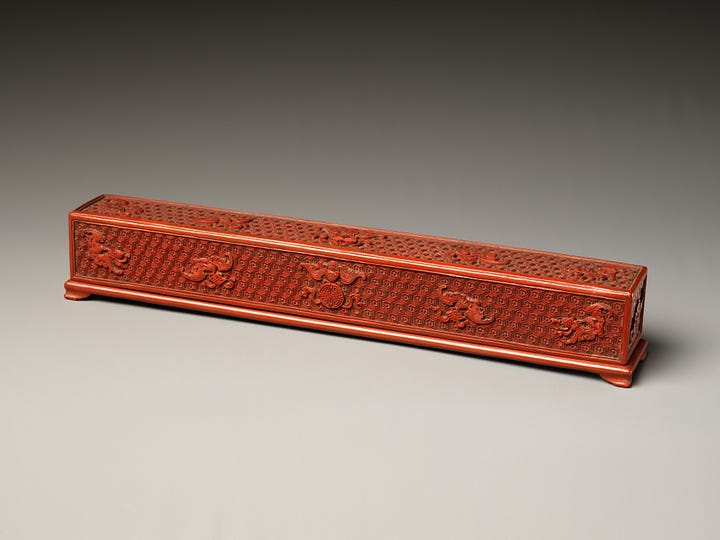
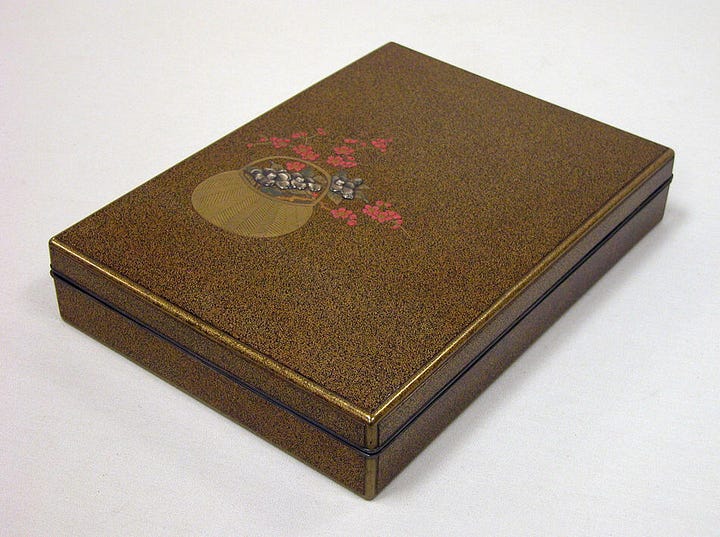
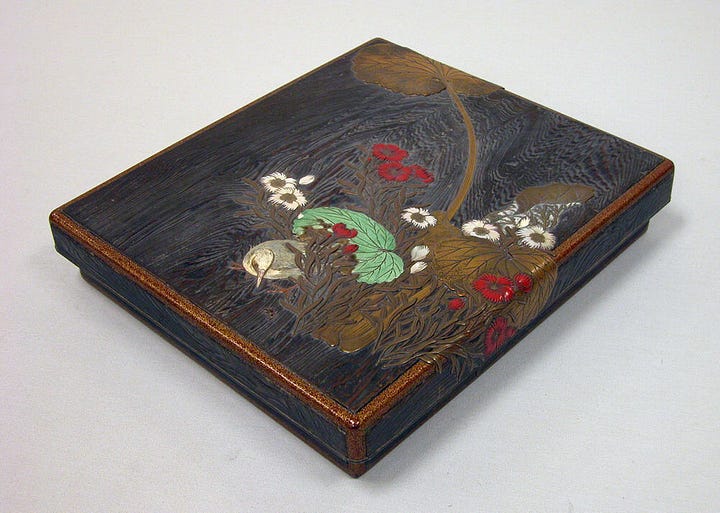
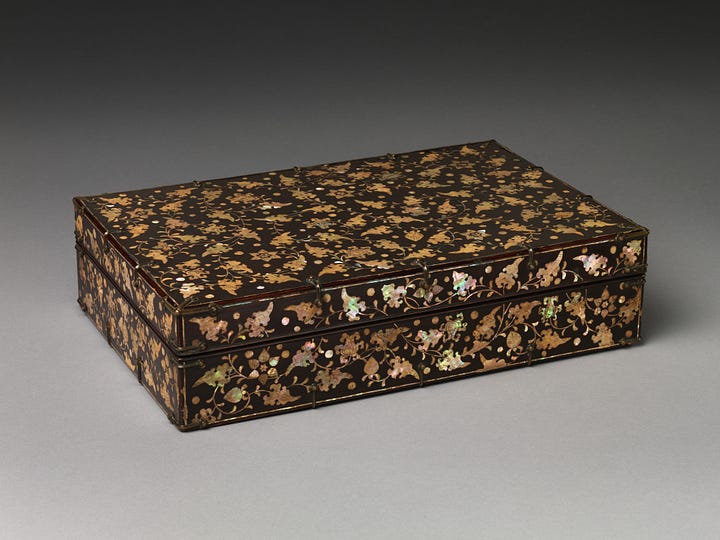
In Asian art we see the natural world in full bloom ~ as flowers, as trees, as water, as mountains, as insects, as birds, as animals. “From dragons to plum blossom — nature has played an important role in Asian art from the earliest dynastic periods.” (Nature is such an important theme in Asian art. To learn more, please click on the link above.)
In the first intricately carved wooden Chinese lacquer box image ‘bats’ are featured throughout. In Chinese art, literature, and folklore, bats, unlike here in the West, are viewed as creatures that bring people great joy and abundance.
In the 2nd and 3rd Japanese colored lacquer and gold maki-e writing boxes, we see lovely images of nature- a basket of flowers dancing in the wind and a sweeping image of a bird surrounded by pink & butterbur wildflowers. There is a gentle beauty to Japanese art- a harmony happening between us and nature. ( This is a concept rooted in Shinto and Buddhist beliefs.)
The third photo above shows a striking Korean inlaid lacquer writing box with mother-of-pearl peonies and acanthus leaves. Koreans hold peony flowers in high esteem as they represent feminine beauty and foretold of a happy marriage.

Vegetal & Geometric Patterns ornament Islamic Writing Boxes…
India & the Islamic World


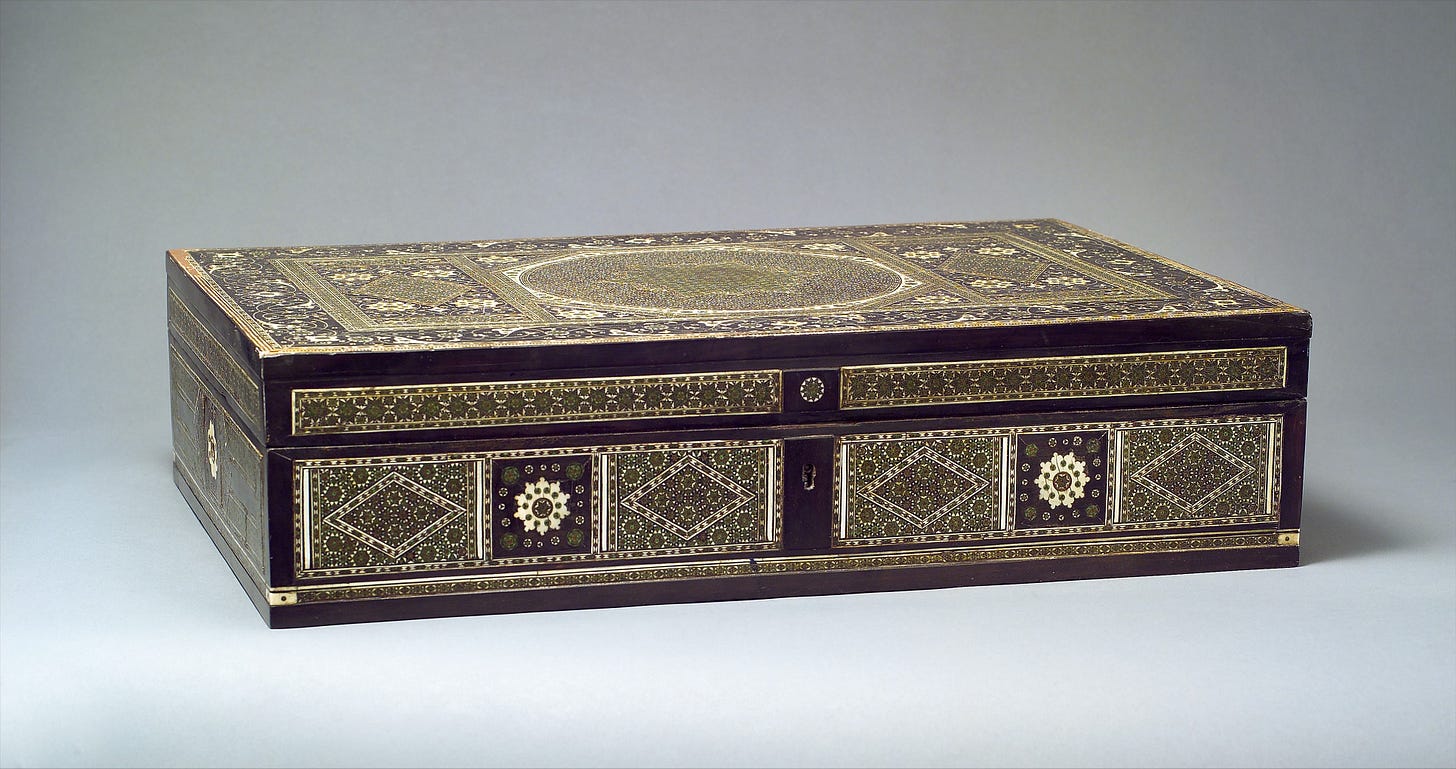
In the Islamic world, objects were adorned primarily with vegetal (stylized flowers, foliate, or fruit) or geometric patterns- as evident in the three images above. The reason for this is that Islam forbade the depiction of living things. There were, however, motifs and patterns used in combination with figural representations- this is particularly true of objects from India for the purpose of storytelling. But overall, vegetal motifs and geometric patterns were used to depict the spirit of things rather than their physical form.
Geometry stressed the importance of unity and order. Using these congruent patterns was a significant intellectual contribution from Islamic mathematicians, astronomers, and scientists. “Astronomical knowledge fulfilled a utilitarian function in the Muslim world by facilitating the proper ritual practice of Islam. Daily prayers occur at times determined by the sun's position and are always performed facing the direction of the holy city of Mecca, where the Ka'ba, Islam's holiest shrine, is situated.”
Islamic art which features stylized foliage with intertwined flowing lines or repeating linear patterns and bold colors is referred to as Arabesque. In French it means “in the Arab fashion”- however few scholars of Islamic art use it today. This Islamic style can be traced back to ornamental styles from Persia, China and the Near East.
It is also interesting to note that with the exception of the garden and its reference to paradise, vegetal motifs and geometric patterns in Islamic art are largely devoid of symbolic meaning.
We can clearly see the vegetal patterns in the first Writing Box with Lattice and Flower Design from Deccan, India (made of wood overlaid with dyed wool, stamped silver and gilt-copper plaques) and in the second Iranian inkwell with Zodiac Signs (made of brass and inlaid with silver, copper, and black compound.) As noted earlier, the Iranian inkwell refers back to how knowledge of astronomy was critical to the Islamic world.
The third Writing Box from India or Pakistan is decorated with a repeating geometric pattern framing floral motifs. The Met Museum’s description speaks to its complexity of craftsmanship. “The surfaces of this writing box are veneered with ebony and inlaid with ivory and sadeli, a type of ‘micromosaic’ in use since antiquity.” (For more on micromosaics, see my newsletter on Mosaics: The Classics Reimagined.) “It is associated with the eastern Mediterranean region, from where it spread to Iran and India. This technique consists of binding together sections of diverse materials (tin, wood, ivory, bone, etc.), which are sliced transversally and formed into thin sheets of repeating patterns that are adhered to a wooden support.”
~~~~~~~~~~~~~~~~~~~~~~~~~~~~~~~~~~~~~~~
Decorative Writing Boxes act as visual stimulants to the writing process…
Can you envision how one must have felt having an exquisite writing box sitting on top of a desk as one began to write? I would imagine there would have been a visual and tactile sensation one would experience reaching for this box to retrieve writing instruments.
And whether this writing would have taken the form of Calligraphy or Arabic letters or the English language- beautiful forms of writing unto themselves- this box would have opened a world of ‘penning possibilities.’
With regards to writing…
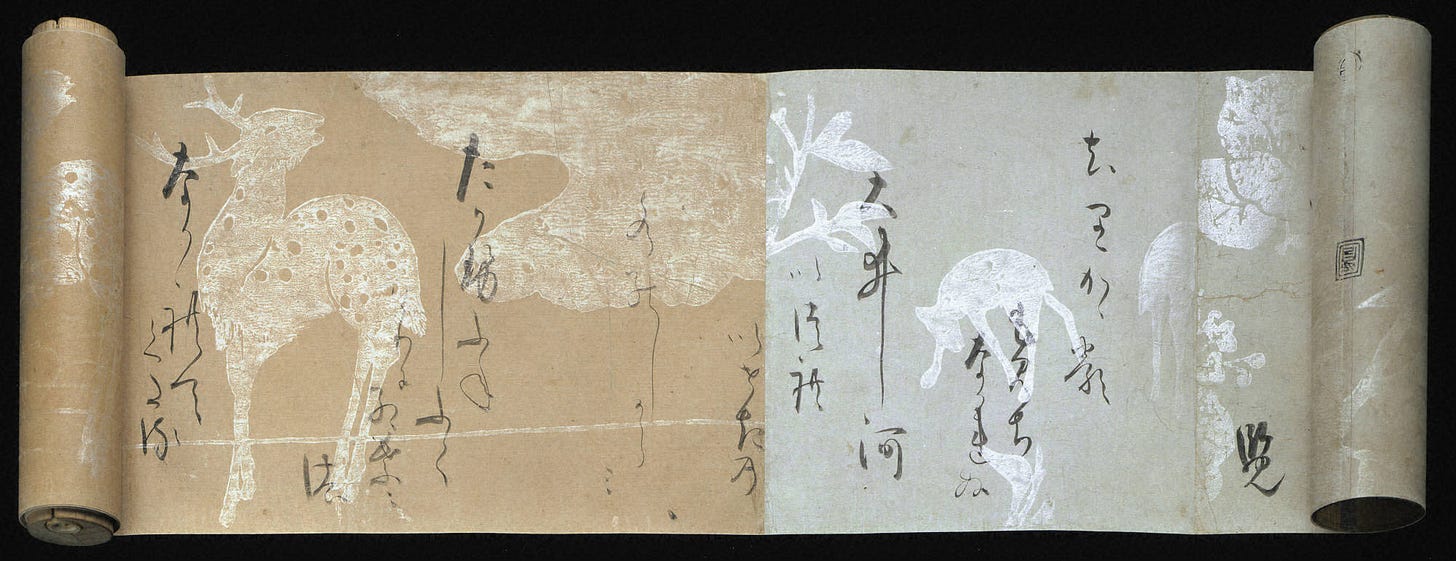
ぴいと啼く 尻声悲し 夜の鹿 (Autumn haiku poem of Matsuo Basho (1644-1694)
The cry of “Pii”.
The last of the voice is so sad.
The night deer.
The Journey of Life (By Rumi)
The journey of life, a test of our will,
A path filled with joys, sorrows, and thrill.
Through moments of laughter and moments of strife,
We navigate the winding road imbued with life.
Enjoy reading and please subscribe to my free newsletter below. Comments are welcome!
Thank you for reading Donna’s Substack- The Object Is the Story! Subscribe below for free to receive new posts and support her work.






A beautifully written article on the art of writing. One of a kind. A must read!